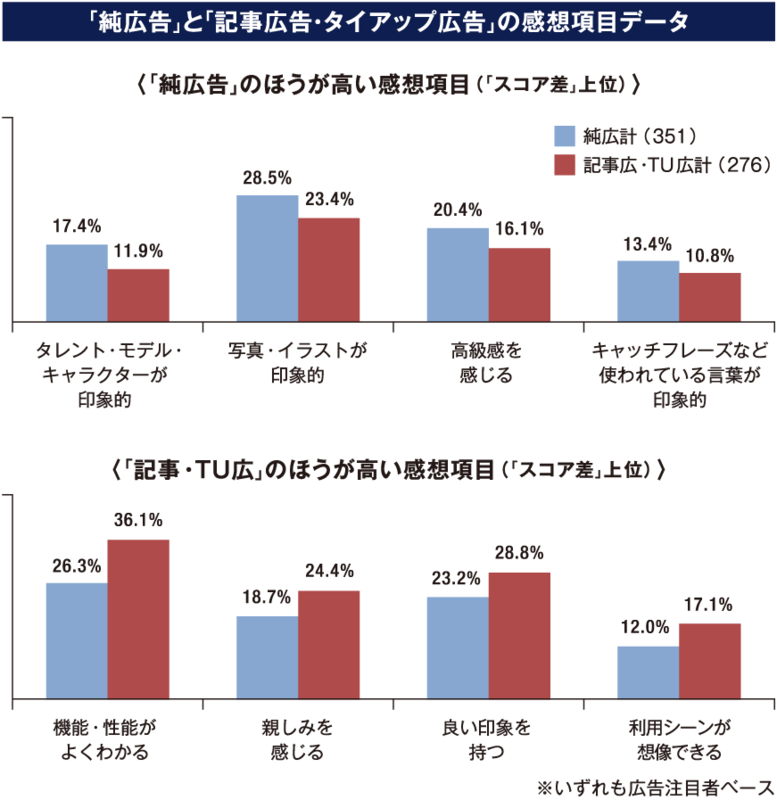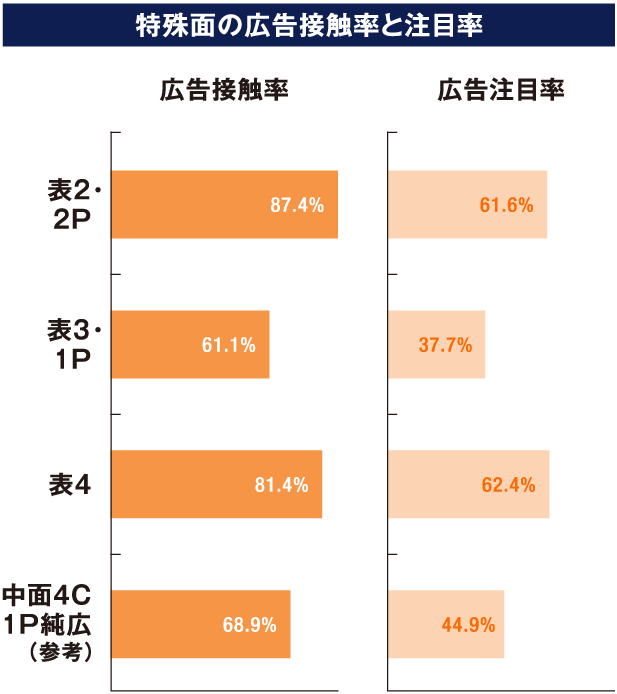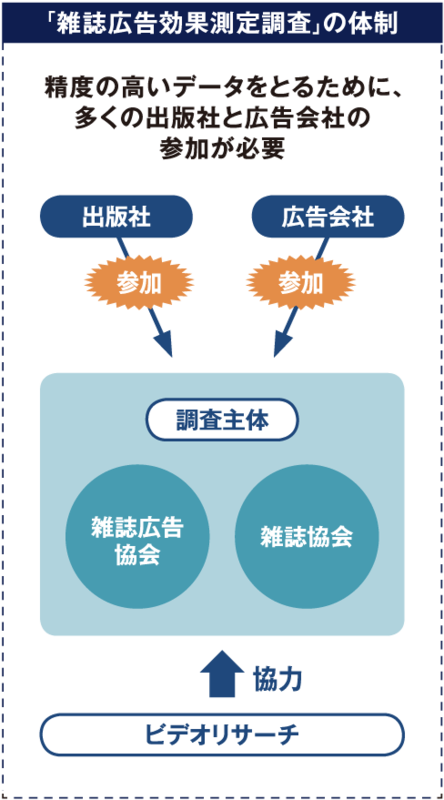Note: This website was automatically translated, so some terms or nuances may not be completely accurate.
Visualizing the Effectiveness of Magazine Advertising! "First M-VALUE" Report

Japan Magazine Publishers Association

Japan Magazine Advertising Association
| |
The Japan Magazine Publishers Association (JMPA) and the Japan Magazine Advertising Association (JMAAA), with the cooperation of Video Research Ltd., conducted a magazine advertising effectiveness measurement survey in October 2013. This was the first survey aimed at establishing and accumulating objective benchmarks for magazine advertising usable across the industry. The survey was named "M-VALUE" to convey the desire to communicate the true value of magazine advertising. The survey covered 627 ad materials from 33 magazines published by 19 companies, securing approximately 150 monitors per magazine. This represents the first attempt at a standard industry-wide survey measuring advertising effectiveness. Here, we present an overview of the results and key points of the survey. |
|
■Average Attention Rate for Magazine Ads: 50.2%
The average attention rate (the percentage of readers who "read in detail + definitely saw" the ad) for the 627 materials surveyed was 50.2%. On average, magazine ads are firmly recognized by roughly half of readers. Among those who noticed the ads, over 60% expressed "interest" in the advertised products/services, and 50% indicated an "intention to purchase/use."

■Psychological Changes and Responses After Seeing Ads
Regarding specific emotional shifts among ad attention recipients: * About 25% express an information desire, saying "I want to know more." * Around 20% each report that "the product becomes noticeable" or "I feel like going to the store to see it." Furthermore, 7% of attention recipients take concrete actions: * 7% search the official website. * About 4% visit the store or consider purchasing. * About 9% share word-of-mouth with others.

■What Do "Pure Ads" and "Article Ads/Tie-in Ads" Communicate Best?
Comparing impressions by ad type reveals that "Pure Ads" outperform others in impact aspects like character impression, catchphrase impact, and conveying a sense of luxury. Conversely, "Article Ads/Tie-up Ads (TU Ads)" excel in areas showing the distance between the product/service and the reader, such as understanding features/performance and fostering familiarity. This demonstrates how the article-style presentation makes the product/service feel more relatable.

■ Advantages of "Special Pages (Front Cover Area)"
In magazine advertising, the placement position—where the ad appears—is also a crucial factor. Among these, the front-end pages serve as the magazine's "other face," a position that can suggest the readers' preferences. Comparing the effectiveness of these "front-page pure advertisements" to the average of all 627 materials, the attention rates for both the "Inside Front Cover" (back of the cover) and "Back Cover" positions exceed the overall average (50.2%) by more than 10 percentage points. On the other hand, the "purchase/usage intent" after seeing the ad does not show a significant difference from the overall average (50.2%). These two positions, in particular, appear highly effective at capturing readers' attention and ensuring the ad is thoroughly viewed. For example, while the average attention rate for "Inside Pure Ad 4C1P" (color ads on general pages) is 44.9%, the same-sized "Front 4" position demonstrates approximately 1.4 times the effectiveness. Notably, "Front 3" slightly underperforms the overall average for both metrics.

■Three years since the working group's launch.
Through extensive discussion and research, we conducted groundbreaking industry-first surveys.
Magazines have long been considered a medium where advertising effectiveness is harder to quantify compared to TV or the internet. This is because magazines vary greatly in type and target audiences, making it difficult to measure advertising effectiveness as a single metric or compare across different magazines. At the same time, advertisers demand clear criteria for choosing which media to place ads in. This is because advertising is communication that only works when it resonates with the target audience; without that resonance, advertising effectiveness cannot be expected.
Looking at the magazine advertising industry, it's not as if there is no data at all to serve as a benchmark for placing ads. For example, the Japan Magazine Publishers Association (JMPA) publishes "Magazine Data" four times a year, disclosing magazine print runs. Additionally, there is the "Magajenne" advertising effectiveness measurement project, conducted by five publishers targeting ten women's fashion and beauty magazines, and Video Research Ltd.'s magazine advertising exposure effect survey, "MAGASCENE AD." Publishers have also individually measured the advertising effectiveness of their own magazines.
However, there has been no standard industry-wide survey for measuring advertising effectiveness. As the media and economic environments changed, the publishing industry also felt the need for new initiatives. Then, upon receiving a request from the Japan Advertisers Association (hereafter JAA) to "establish a method for measuring advertising effectiveness for the entire magazine advertising industry," discussions began on specific methodologies. In October 2010, a working group was formed with the JAA and the Advertising Subcommittee of the JMA, comprising 10 member publishers (Orange Page, Kadokawa Magazines [now KADOKAWA], Kodansha, Kobunsha, Shueisha, Shufu to Seikatsusha, Shufu no Tomo Sha, Shogakukan, Nikkei BP, and Magazine House). The group engaged in extensive discussions and research.
The conclusion was that to advance the work, it would be desirable for advertising agencies and research firms to join the working group. In September 2011, participation was requested from Dentsu Inc., Hakuhodo DY Media Partners, Asatsu-DK, and Video Research Ltd., which was accepted. Furthermore, with cooperation from the Japan Magazine Publishers Association (JMPA), it was decided that the JMPA and JMPA would be the primary research entities. An experimental survey was conducted from November to December 2011. The issues highlighted during this survey were examined one by one, and the survey methods were improved. Subsequently, the first Magazine Advertising Effectiveness Measurement Survey "M-VALUE" was conducted in October 2013.
■Aiming to establish and accumulate objective benchmarks usable across the industry
As the name "Magazine Advertising Effectiveness Measurement Survey" suggests, this survey measures the effectiveness of magazine advertising from various perspectives, including contact rates and attention rates. However, its goal is not simply to indicate whether magazine advertising is highly effective or not. Since there were no industry-wide metrics to begin with, the primary purpose of this survey is to "establish and accumulate objective benchmarks for magazine advertising that can be used across the industry."
Long-term, a major goal is to bring advertisers and magazines closer together by having advertisers utilize the accumulated data as a reference point when placing ads. For example, adding industry-standard objective data to the data each advertiser collects independently enables comparative verification. If this leads to more effective marketing activities in magazines, the survey's significance will be substantial. As an industry, we also hope this survey will contribute to enhancing the value and revitalizing magazine advertising.
■Numerous refinements and considerations in survey methodology to ensure high precision
Three key points were particularly emphasized in the survey: "properly gathering readers," "conducting the survey while recreating the state of reading the magazine," and "surveying all advertisements."
Regarding survey monitors, Video Research Ltd. confirmed each individual was a reader of the target magazine before inviting participation. We ensured monitor numbers were consistent across magazines and secured approximately 150 monitors per title, carefully considering the gender and age composition of each magazine's readership.
Responses were collected by mailing the magazines to monitors as survey materials. Monitors read the magazines for a set period, then accessed the survey site via computer to answer questions. A key point was requiring monitors to keep the magazine handy while answering. This allowed them to reconfirm where ads were positioned and which ads they had actually looked at while completing the survey questionnaire. This approach made it easier for monitors to recall their initial impressions during the first reading, leading to more accurate responses. It also enabled us to properly measure the effectiveness of premium ad positions, such as special inserts.
We also took care to avoid bias in the selected advertisements. Video Research Ltd. selected the materials, checking the ratio of pure ads to tie-up ads within each magazine and the proportion of different industries represented in the ads. This ensured the surveyed ads reflected the overall advertising composition of the magazine as closely as possible. For example, if cosmetics made up 50% and food 20% of the published ads, the survey materials aimed for a similar ratio. Furthermore, we made it mandatory to survey ads on special pages.
Beyond this, we designed the survey items considering that magazine advertising, more than simply expanding reach, has a significant media characteristic of driving psychological change and response actions—making people want the product or visit the store after seeing it. We have enhanced our measurement items to include not only contact rates and attention rates, but also changes in feelings, actual actions, and word-of-mouth behavior triggered by seeing the ad. Simultaneously, we have added questions evaluating creative impressions from the ad visuals, striving to collect data from various angles.
Furthermore, to establish comprehensive data across various magazine genres, we invited participation from publishers to cover weekly magazines, business/money magazines, women's youth magazines, lifestyle/practical information magazines, and beauty/cosmetics magazines.
Beyond establishing this survey framework, we resolved the long-standing issue of survey costs. Participating publishers, advertising agencies, and Video Research Ltd. will jointly fund the surveys. We also finalized a system to provide the survey results to advertisers and advertising agencies who require this data, offering it for a fee to facilitate its utilization.
■Widespread participation from publishers and advertising agencies is essential to improve survey data quality
After completing the first survey, the framework for the survey methods and items is largely established. By conducting repeated surveys going forward, guidelines for the numerical data of each item should become apparent, and benchmark values for evaluating individual advertisements will be refined. This survey is planned to continue at an annual pace.
| |
|
Future considerations include determining the optimal survey timing, as a fixed schedule may limit the seasonal diversity of advertised products and services. There is also room for discussion on better utilizing the accumulated data and sharing successful implementation cases across the industry.
The most immediate challenge is increasing the number of participating magazines. While this survey covered 33 titles from 19 publishers, some genres had only one participating magazine, making it difficult to identify genre-specific characteristics. Effective benchmarks require broad participation across all genres. Improving data accuracy and quality necessitates participation from more publishers and magazines. Furthermore, expanding the survey's scale to enable industry-wide adoption of this framework requires indispensable cooperation from advertising agencies. Specifically, the cost burden per company decreases as more companies participate. Since participating in the survey offers benefits to advertising agencies as well, we ask both publishers and advertising agencies to deepen their understanding of this survey and cooperate.
If the data obtained through this survey becomes recognized as the standard for magazine advertising, advertisers will also be able to confidently explain their choices when placing ads. We hope for the participation of many companies, both to encourage greater use of magazines for advertising placements and to foster the development of the magazine advertising industry through this new initiative.
| |
First Magazine Advertising Effectiveness Measurement Survey "M-VALUE" Overview〈Survey Method〉 Internet survey via personal computer 〈Survey Area〉 7 major regions nationwide (16 prefectures) 〈Survey Participants〉 〈Survey Target Magazines〉 〈Number of Survey Ad Materials〉 Up to 20 materials per magazine 〈Survey Items〉 〈Survey Agency〉 Video Research Ltd. |
|
Was this article helpful?
Newsletter registration is here
We select and publish important news every day
For inquiries about this article
Author

Japan Magazine Publishers Association
<a href="http://www.j-magazine.or.jp/" target="_blank">http://www.j-magazine.or.jp/</a>

Japan Magazine Advertising Association
<a href="http://zakko.or.jp/" target="_blank">http://zakko.or.jp/</a>

 Magazines were mailed to respondents on the issue's release date; responses were collected via the survey site after a designated reading period
Magazines were mailed to respondents on the issue's release date; responses were collected via the survey site after a designated reading period